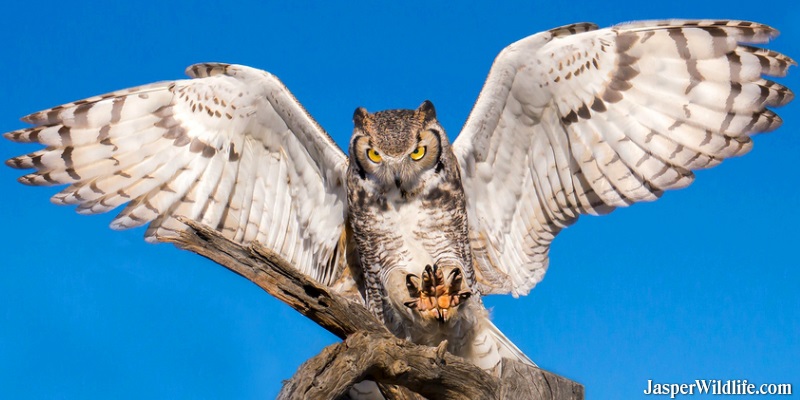(Bubo virginianus) Great Horned Owl
Description of Jasper's Great Horned Owl
- Mass: up to 2 kg
Wingspan: up to 1.2 m
Canada's Great Horned Owl gets it's name from the large ear tufts, which it can move in hightened moments. While these tufts are not ears, great horned owl's ears are indeed hidden beneath its' feathers on the side of their heads.
Great Horned Owl's Flight
As with most Owls, Great Horned Owls can fly absolutely silently. Silent flight is facilitated by loose, soft outer edge flight feathers that allows air to rush by without making a sound.Great Horned Owl's Appearance
Great Horned Owls are dark grayish brown with white molting high and buff-white lower down. Bright yellow eyes allow high amounts of light in for night hunting and widely spaced ears offer great horned owls spectacular hearing. All great horned owls have dark brown barring all over the body with the exception of a white throat.Great Horned Owl's Habitat
Throughout Northa America, Great Horned Owls prefer forested areas as well as open country, swamps and even city parks. Great Horned Owls typically do not migrate.Adult Great Horned Owls are formidable predators and have few natural enemies, though some may be killed or seriously injured when attacking large-size prey. Crows and magpies will frequently harass roosting owls during the daytime, but this if often just a minor annoyance to adults. Great Horned Owls normally do not move far from the area in which they were born.
Hunting and Prey
Great Horned Owls are capable of handling a wide variety of prey, ranging in size from shrews and songbirds to skunks and geese. Typically, the Great Horned Owl depends upon medium-size mammals and birds in Canada, where its food habits are well documented. Rabbits and hares are a staple part of the diet in many regions, and grouse and ducks are also important prey. When mice or voles are abundant, owls will consume large numbers of them.Fur, feathers, teeth, and bones are indigestible; compacted in the owl's stomach and later regurgitated, or brought up, as "pellets." One or more of these may be expelled daily, depending upon the volume and type of food eaten.

